Let’s get this out of the way right up front: Jack Kirby did not sue Marvel Comics. He may have made some legal threats over the last decade of his life, but he did not file suit. The now famous lawsuit against Marvel was brought forward by the Kirby family and was similar to that of Joe Simon - Copyright Terminations. It did not involve who created what.
The case has been talked about and covered by countless of people over the years. Most haven’t got a single clue as to what went on, or what it was about and, as such, they draw the wrong conclusions. Others were actually involved and know more than others. I covered the case as it was happening - my posts about the case are in the archives here and, if anyone wants, I’ll consider posting them back out there for free.
(And yes, I was involved, albeit on a peripheral level when an old interview that I conducted with Larry Lieber was introduced as evidence. I had no idea this had happened until I saw in an exhibit filing.)
The case divided comic book fans into two camps - those for Marvel and those against. There are those who felt, and probably still do feel, I was for Marvel in this one.
For the record, I wasn’t for Marvel. I wasn’t for Kirby either. I just documented what happened and what I felt would happen, and that the Kirby case would fall at the last hurdle, which it did. Personally, for what it’s worth, I felt that Marvel should have settled well before they did. It only caused damage to their brand to keep such a case going in the public arena against one of it’s most revered creators, and a creator that deserved to be richly rewarded.
And yes, Kirby deserved to die with as much money, if not more, than Stan Lee. Sadly he didn’t, and no court filing will ever change that fact.
Back to the case, Marvel Worldwide v Kirbys.
Here’s a quick summary, taken from the court documents (in quotes).
In June 1972, Marvel had Kirby execute an assignment to Marvel Management Company of any and all right, title and interest (including specifically any copyrights, whether statutory and at common law) that Kirby "may have or control" in any of the works Kirby created for Marvel. The assignment did not state that Kirby actually owned any copyright in the works; on the contrary, the assignment contained an acknowledgement that Kirby had created the works "as an employee for hire" of the owners of Marvel, the Goodmans.
This original document made clear that Kirby would not file against Marvel. It was signed when Kirby was working at DC Comics.
Of interest, this document was designed to prevent Kirby from filing for the same Captain America comics that Joe Simon was trying to get. And, to this end, the Kirby family didn’t file for those issues.
Now the important part.
On September 16, 2009, the Kirby Heirs served Plaintiffs with 45 notices purporting to terminate Kirby's assignment of his federally-protected copyrights in a number of Marvel editions that were published between 1958 and 1963: Amazing Adventures, Vol. 1, Nos. 1-6; Amazing Fantasy, Vol. 1, No. 15; The Amazing Spider-Man, Vol. I, Nos. 1-7; The Avengers, Vol. 1, Nos. 1-2; The Fantastic Four, Vol. 1, Nos. 1-21; The Fantastic Four Annual, No. 1; Journey Into Mystery, Vol. 1, Nos. 51-98; The Incredible Hulk, Vol. 1, Nos. 1-6; The Rawhide Kid, Vol. 1, Nos. 17-35; Sgt. Fury and His Howling Commandos, Vol. 1, Nos. 1-41 Strange Tales, Vol. 1, Nos. 67-115; Tales of Suspense, Vol. 1, Nos. 1, 3-48 and Tales to Astonish, Vol. 1, 8.
The Kirby’s were asking for the copyright to the stories and any and all characters in those issues. These included the first seven issues of Spider-Man, a title that Kirby did not work on - ironically, it missed issue #8, which Kirby did work on, penciling and plotting a story featuring The Human Torch.
In short, the Kirby family were asking for the first six years of the Marvel Universe, lock, stock and barrel, no matter who might have created the characters. At no point was the fight about who created Thor or Iron Man, it was about who was the rightful owner of the copyrights of those comic books.
Some of the comics the Kirby family were claiming would be re-litigated down the track, but we will get to that. Back to the case.
Marvel attempted to negotiate their way out of litigation, but the Kirby’s dug in. Thus Marvel brought action to protect their IP - as you’d expect. Marvel argued that the Kirby family couldn’t file copyright terminations because Marvel, and not Kirby, were the rightful owners of the copyrights.
Creation of characters wasn’t the issue here. The court made it very clear that it didn’t care who created the characters, and that the case was about whether Stan Lee or Jack Kirby were the real ‘creator’ of the Marvel Universe, or if Kirby (or any other freelancer) were treated fairly by Marvel, or any other company. The court had to clarify this as most reporting around the case focused on those points and not the actual litigation. As the court stated.
It is about whether Kirby's work qualifies as work-for-hire under the Copyright Act of 1909, as interpreted by the courts, notably the United States Court of Appeals for the Second Circuit. If it does, then Marvel owns the copyright in the Kirby Works, whether that is "fair" or not. If it does not, then the Kirby Heirs have a statutory right to take back those copyrights, no matter the impact on a recent corporate acquisition or on earnings from blockbuster movies made and yet to be made.
It was clear the case revolved around work for hire. Did Kirby do all of that work as an employee of Marvel Comics? Marvel believed so, and pointed to the document Kirby signed in 1972 saying so, the Kirby family disagreed.
The court ultimately ruled in Marvel’s favor.
I conclude that there are no genuine issues of material fact, and that the Kirby Works were indeed works for hire within the meaning of the Copyright Act of 1909. Therefore, the Section 304(c) Termination Notices did not operate to convey any federally-protected copyrights in the Kirby Works to the Kirby Heirs. Marvel's motion for summary judgment is granted; the Kirby Heirs' cross motion is denied.
The whole fifty page judgement makes for interest, if very dry, reading. Here’s how the court found the works were created, based upon the depositions and declarations of Stan Lee, Roy Thomas, John Romita, Larry Lieber, John Morrow, Mark Evanier, Jim Steranko, Dick Ayers, Joe Sinnott and more. The court also considered interviews, articles, documents, checks that Kirby had signed, assignments, plots, scripts, un-used artwork, contracts - a trove of information was taken in, studied with zero emotion, and assessed.
Here’s what the court concluded from all of that data when it came to the comic books.
During the period 1958-1963, when the Kirby Works were created, Lee supervised the creation and publication ofMarvel's comic books from beginning to end. Nothing was published without his approval. Lee reviewed every artist's work before publication. If artwork was "confusing," if more "action" was needed, or if a script had too much or too little dialogue, Lee was responsible for "mak[ing] the stories as good as [they] could [be]." It was not uncommon for Lee to make changes to artwork or a script without first consulting the artist or writer.
Lee reported to Goodman. As the publisher and owner, Goodman "was the ultimate boss," and had the final say over what comics Marvel published. If Goodman did not approve a comic book, it was not published. Occasionally, Goodman would request changes to artwork or a story; Lee was responsible for ensuring that the artist executed Goodman's changes.
The Marvel Method
During Lee's early years as art director/editor, either he or another writer prepared detailed "scripts" for new issues of comic books. These scripts consisted of a panel-by-panel breakdown of the story for each page and explicit instructions about what action should be drawn for each panel and what dialogue would be inserted to accompany the art. Only after a script was prepared was an artist asked to start work on the comic. During this period, the freelance artists who drew for Marvel had to wait for Lee to write a story before they could draw it.
Predictably, Lee could not write enough stories to keep up with the artists, who wanted new stories to draw as soon as they finished an assignment. So to ensure that his artists always had an assignment, Lee invented what became known as the "Marvel Method." He could not place the invention of the Marvel Method at any particular moment in time, other than to say that it evolved during the 1950s.
Under the Marvel Method, Lee would not write a detailed script for a story before assigning an artist to draw it. Instead, at a "plotting conference," or in a "plot outline," Lee gave the artist the general contours of the story he had in mind: an outline of the plot, a description of the hero, and suggestions for how the story should look.
The artist would draw the story along the lines of Lee's "main theme." After an artist completed the pencil drawings, Lee edited his work and added dialogue and captions. Use of the Marvel Method allowed Lee to keep multiple artists working on assignments simultaneously.
Obviously, the Marvel Method gave an artist greater opportunity for input into the process of creating the characters and the stories. However, even under the Marvel Method, artists did not work "on spec;" they only began to draw "pages" when they received an assignment and plot synopsis from Lee.
Furthermore, the artists were always constrained by Lee's plot outlines, and Lee retained the right to edit or alter their work, or to reject the pages altogether and not publish them if he did not like them.
Lee used the Marvel Method from the time he created it until he became Marvel' s publisher in the early 1970s.
How Marvel Paid its Freelance Artists
Between 1958 and 1963, all of Marvel's freelance artists and writers, including Kirby, were paid flat per-page rates for artwork and scripts they produced. Kirby never received royalties for his work.
The Kirby Works
Between 1958 and 1963, Kirby worked on numerous comic book stories for Marvel. Kirby received his assignments from Lee. Kirby did not draw art for Marvel without first receiving an assignment from Lee. Like other artists who worked for Marvel at the time, Kirby created his artwork based on plot outlines or scripts provided by Lee. At plotting conferences, Lee had the final say as to what was included in the comic book. Lee also had to approve Kirby's artwork before publication, and had the authority to require changes or edits to his work. Occasionally, Lee asked Kirby to make changes to his work. According to Lee, Kirby always complied with those requests.
Kirby participated in the creation of the following comic book stories that are the subject of Defendants' Termination Notices:
1. The Fantastic Four
In 1961, Goodman told Lee to create a new team of superheroes to compete with "The Justice League of America," which was published by National Comics. Lee and Kirby co-created "The Fantastic Four." At their first plotting conference, Lee and Kirby discussed ideas for the first issue. Kirby then produced the pencil drawings for that issue. "The Fantastic Four" was originally published in November 1961.
2. The Incredible Hulk
"The Incredible Hulk," a sympathetic hero-monster, was co-created by Lee and Kirby in 1962. Kirby drew the first issue of "The Incredible Hulk," which was published in May 1962. In that first issue, The Hulk had gray skin. However, the printer could not produce a consistent shade of gray throughout the book. By the second issue The Hulk had acquired his now-recognizable green skin. Lee picked the color green because there was no other green hero at the time.
3. The Mighty Thor
"The Mighty Thor" was first published in August 1962. The hero was based on the Norse god of thunder. Lawrence Lieber wrote the script for the first issue, based on a synopsis for the plot created by Lee. Kirby drew the art for the series' first issue.
4. Spider-Man
In 1962, Lee developed the idea for a "nerdy" teenage hero with the power to stick to walls and ceilings like an insect. Lee assigned Kirby to create the artwork for the first Spider-Man story. Lee did not like Kirby's initial pencil renderings of Spider-Man, the character was too muscular and heroic-looking-so he reassigned the comic book to artist Steve Ditko. After Ditko completed his work on the book, Kirby drew the cover. Spider Man first appeared in "Amazing Fantasy" in September 1962. Spider-Man was so popular that Goodman gave the character its own comic book. "The Amazing Spider-Man" was first published in March 1963.
5. Iron Man
Iron Man first appeared in "Tales of Suspense" in March 1963. The first Iron Man comic book was written by Lawrence Lieber, based on a plot from Lee; Don Heck drew the artwork. As with Spider Man, Kirby drew the cover for the comic book's first issue.
6. The X-Men
In 1963, due to the popularity of "The Fantastic Four," Goodman asked Lee to create a new team of superheroes. Lee conceived of The X-Men as a team of mutants who were born with superpowers, or "extra powers;" he also created the character of Professor Xavier, who opened a "School for Gifted Youngsters" where young mutants could enroll and develop their mutant powers. Lee originally named his heroes "The Mutants," but Goodman did not like the name, so the superheroes acquired their familiar moniker. The first issue of "The X-Men" was published in September I 963. Kirby drew the artwork for that issue.
7. The Avengers
Also in 1962, Lee and Kirby developed a new team of superheroes, "The Avengers." "The Avengers" consisted of several existing Marvel superheroes fighting together as a unit rather than separately. Lee conceived the initial plot for "The Avengers," and Kirby drew the first issue, which was published in September 1963.
8. Ant-Man
"Ant-Man" was first published in January 1962. Lee had the idea of a miniature hero. Kirby drew the pencil artwork for the first issue of" Ant-Man," and the panel-by- panel script for the issue was written by Lieber.
9. Nick Fury
"Nick Fury" was based on a discontinued series from the World War II era entitled "Sgt. Fury and His Howling Commandos." Lee brought fury back to life and oversaw the creation of the comic book using the "Marvel Method." Kirby was assigned to draw the artwork for the new series. "Nick Fury" was first published in May 1963.
10. The Rawhide Kid
Lee developed "The Rawhide Kid" because Goodman loved westerns and liked titles that included the word "kid." Lee also wrote the comic book's first issue. Kirby drew the pencil artwork. Eventually, the writing and artwork for "The Rawhide Kid" was reassigned to Lieber. The first issue of the comic book was published in August 1960.
All I’ve removed from the above are the references to depositions, declarations, documents and the like. Don’t come after me, it’s what the court said. I know there’s plenty of people who don’t agree with the above, that’s their right, but don’t shoot the messenger.
After the court found in Marvel’s favor, the Kirby’s appealed. The appeal wasn’t successful as the Second Circuit again found in Marvel’s favor. Finally a deal was finally struck between Marvel and the Kirby family, which would see Kirby given official co-creator and creator status on a number of properties, royalties and a payment.
The case was then closed off.
It was nasty, it was messy and it shouldn’t have gone on for as long as it did. Marvel dropped the ball, and badly, but it did give us the benefit of reading Stan Lee depositions, a lot of which contradicted what he had been saying in interviews over the years, and some of which reinforced his previous comments. It also showed that, more often than not, what people wrote about Lee and Kirby matched up the reality of what happened.
It wasn’t fun.


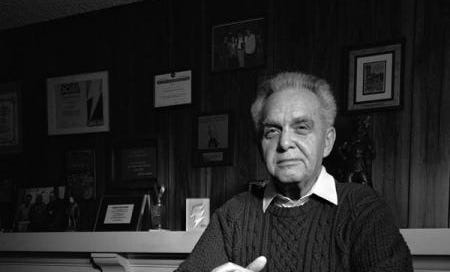



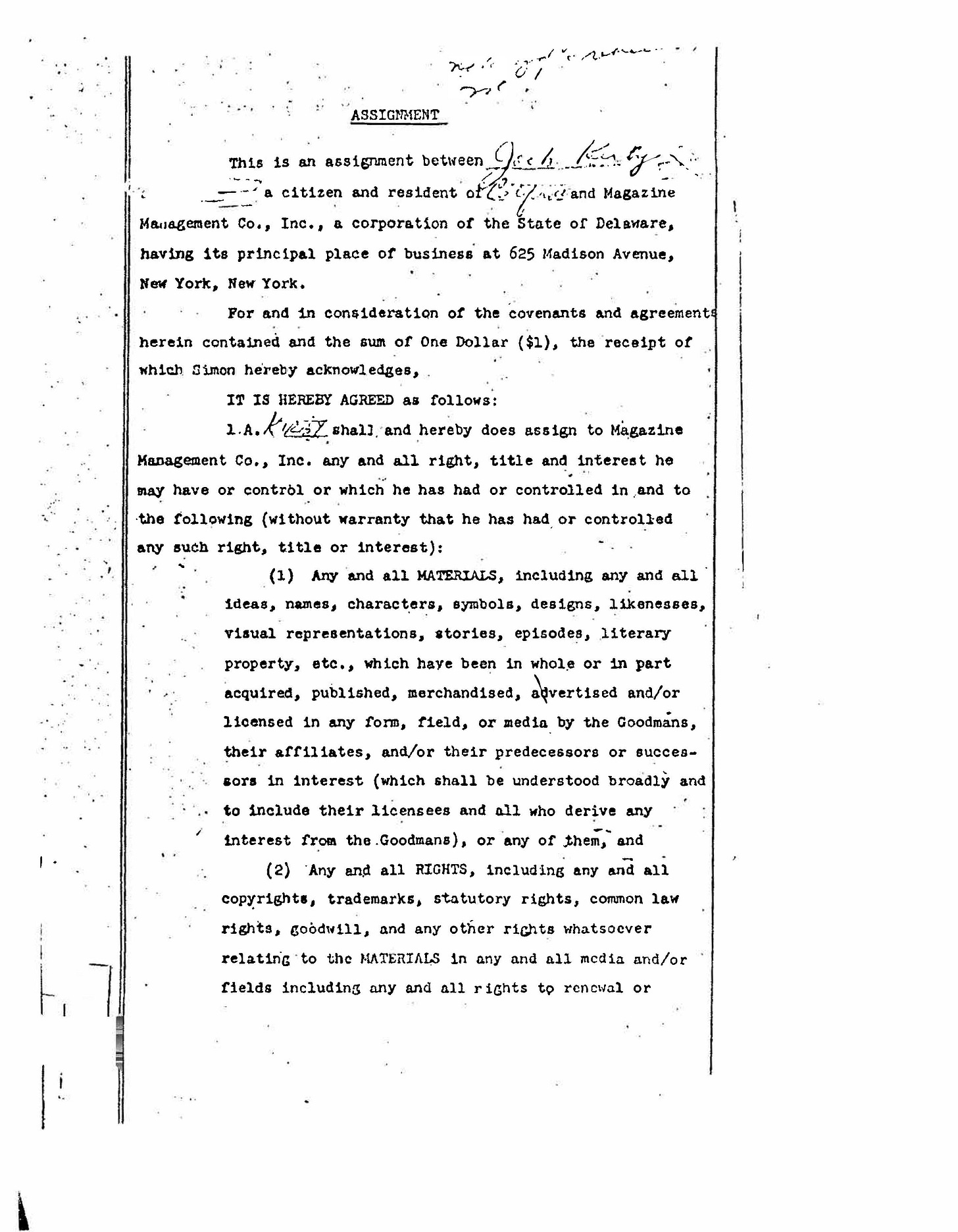
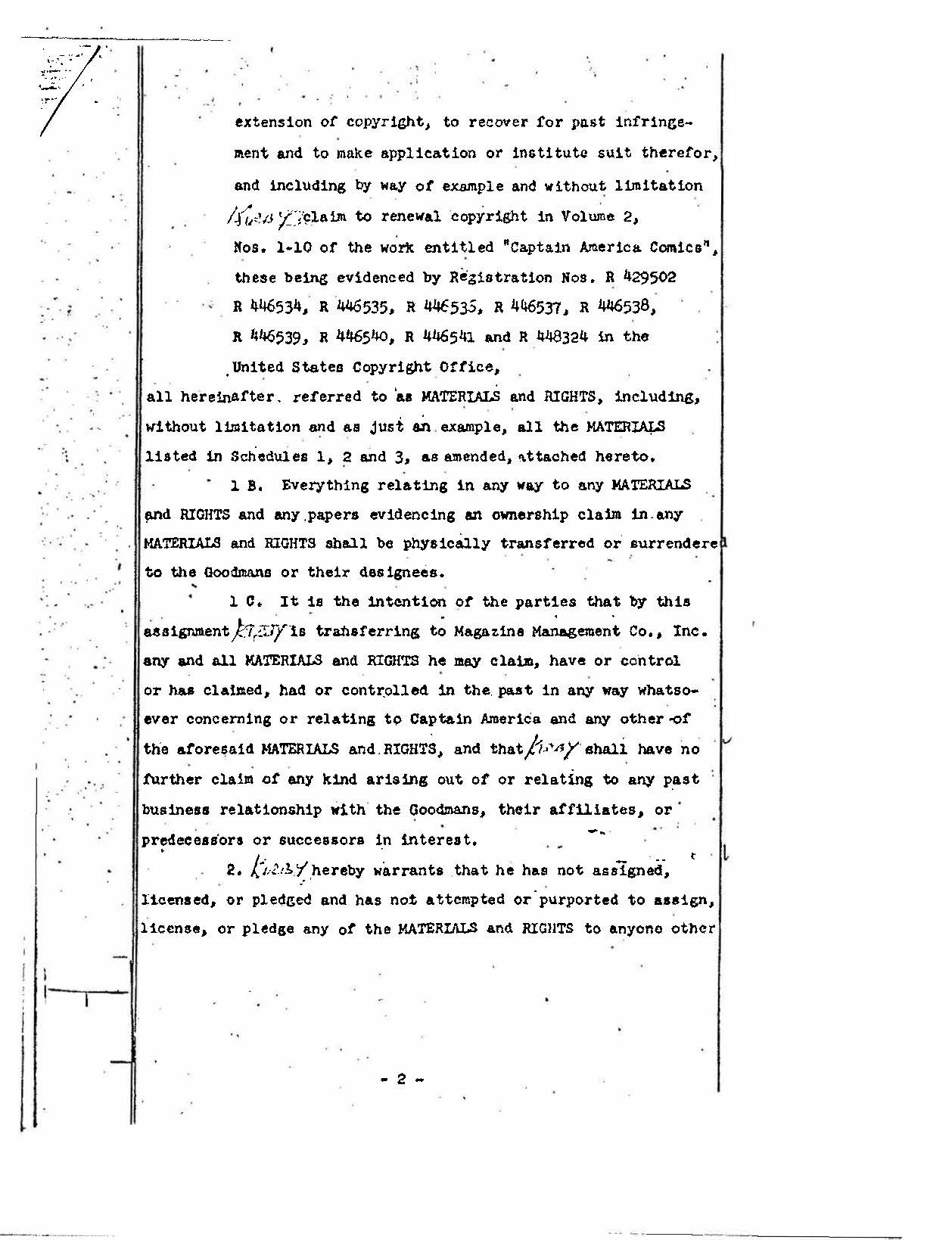
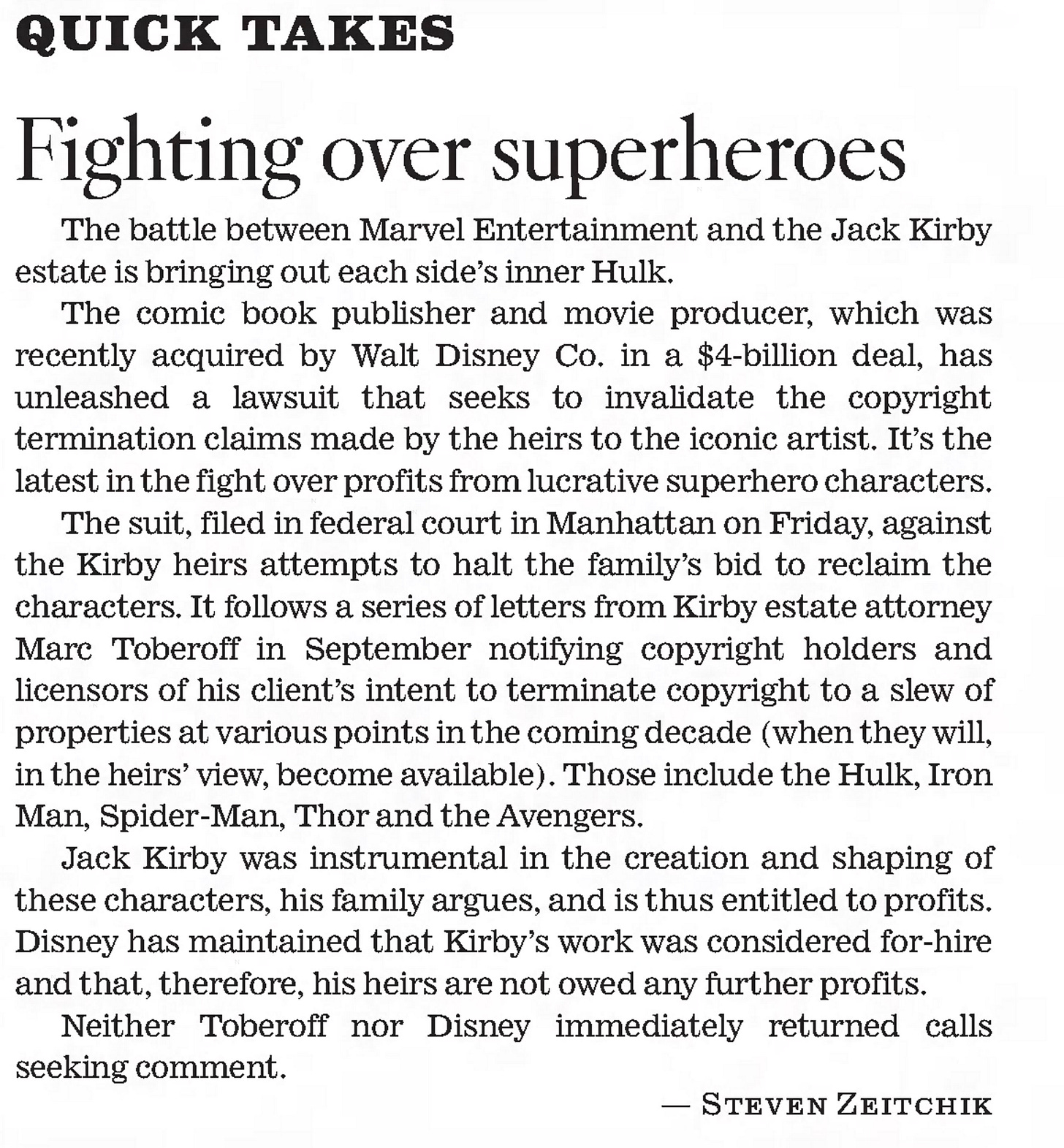
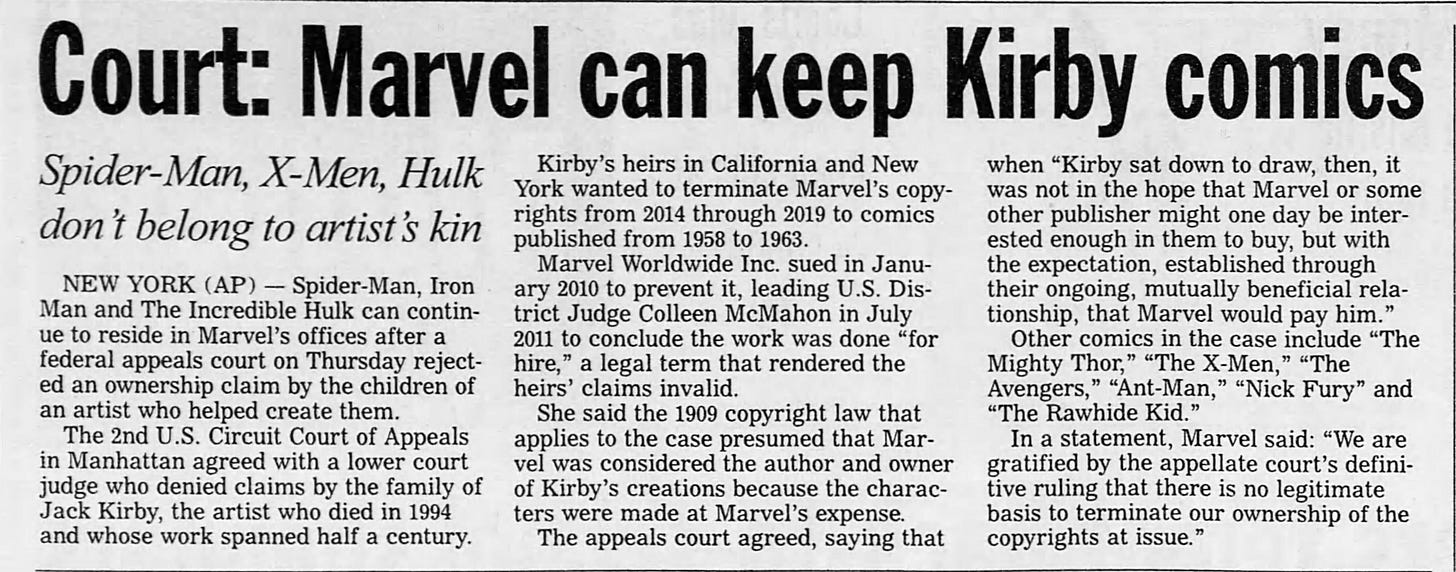
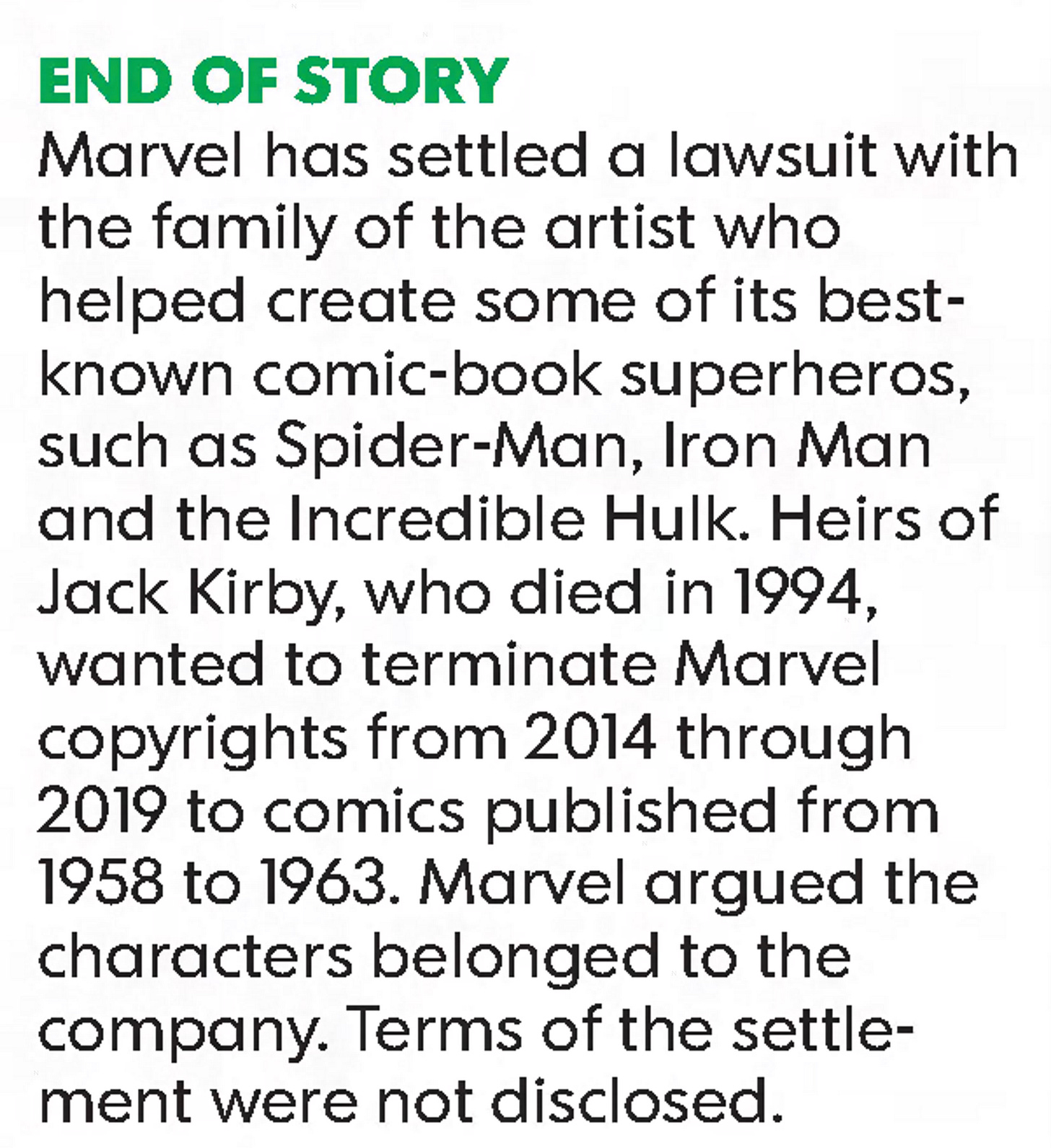
Every now and then, I wonder what the payout to the Kirby’s was. I’ve heard a marginally reliable eight figures, which is likely at any point more than Lee got. The funny thing about the payout to the Kirby’s is that even low eight figures seems like a lot yet given that Disney paid $4b for Marvel, what’s eight figures more? As for who deserves more, Lee or Kirby, it’s pure apples and oranges.
And that’s because a huge factor in the mess is whether Kirby was creating characters without any request from a publisher, producer or whatever. The only things that come close to mind is the Silver Spider (actually a four man creation) and something called Tiger 21 IIRC, which maybe at a producer’s request. So essentially everything — certainly at Marvel — was created at Marvel’s request or maybe even in collaboration with Lee.
Which gets to maybe legal hairsplitting.
Based on researching and drafting a post-trial memorandum of law on the very issue of work for hire, WFH has nothing to do with whether the creator was an employee but whether they were treated as as employee directed to do the work and the like. (My case involved an independent contractor who because of fraud or just bullshit had to create software after wrongly assuring that there was off the shelf software available. Very much not an employee nor were there any such claims.
Now, if the judge said otherwise, well, all I’d add is that they look like they got a lot of the facts wrong in the section you quoted re the various characters.